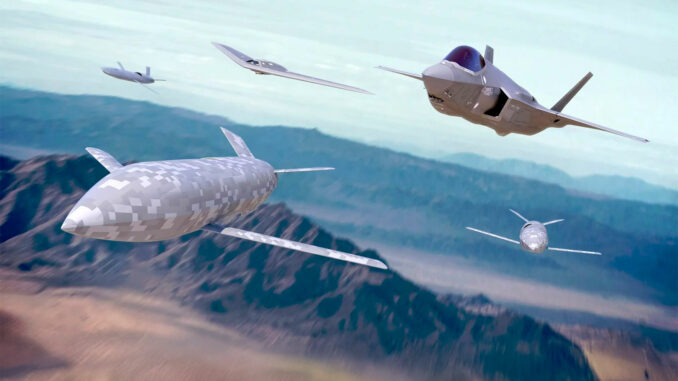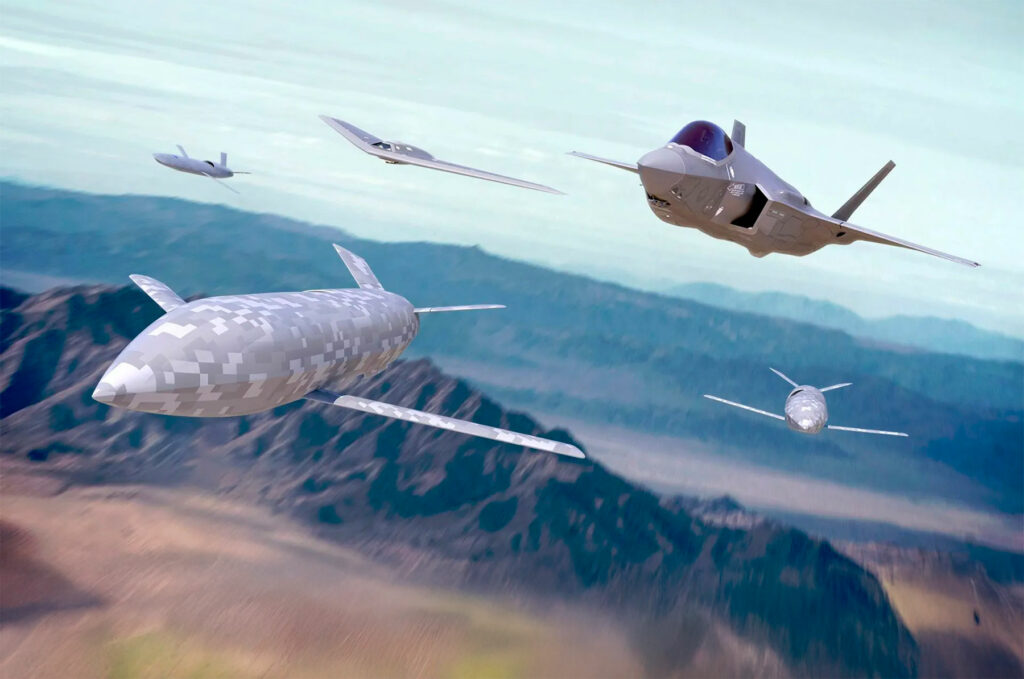
The F-35 demonstrates its advanced UAV control capabilities through artificial intelligence, transforming air operations.
The F-35 and F-22, equipped with tactile interfaces and artificial intelligence systems, can now simultaneously control several UAVs in flight. These advances are part of the US Air Force’s Collaborative Combat Aircraft (CCA) program, aimed at integrating unmanned aircraft into complex operations. Lockheed Martin has demonstrated end-to-end connectivity, enhancing coordination between manned aircraft and drones. These innovations, focused on communications security and drone modularity, are redefining modern military tactics.
F-35 and UAVs: a breakthrough in collaborative combat
Recent demonstrations by Lockheed Martin have confirmed that F-35s can act as “quarterbacks” in modern air operations. Equipped with advanced artificial intelligence systems, the F-35 can coordinate armed and unarmed drones for complex missions. The tactile interface used by pilots simplifies the simultaneous control of several drones, optimizing air combat strategies.
These drones, developed as part of the Collaborative Combat Aircraft (CCA) program, will play a central role in the US Air Force’s domination of the skies. By 2025, some 100 to 150 first-generation CCA drones are expected, and this number could rise to several thousand for later versions. Expected costs for these drones vary according to their sophistication: between €10 and €20 million per unit**, a fraction of the cost of traditional fighter jets.
The strategic benefits of artificial intelligence
The integration of AI into F-35 and F-22 systems enables faster, more accurate decisions in combat. AI analyzes data in real time, identifies targets, and transmits orders to drones under pilot control. Secure connectivity is essential: networks such as Link 16, although powerful, expose communications to interception. To mitigate this risk, solutions such as MADL (Multifunction Advanced Data Link) and IFDL (Intra-Flight Data Link) directional datalinks are being integrated.
In collaboration with companies such as Anduril and General Atomics, the US Air Force is also working to perfect control architectures. These technologies will enable UAVs to operate in contested environments, while reducing their dependence on long-range communications. This ensures that, even in the event of signal loss, drones return to base automatically.
Modularity and budgetary implications
Collaborative drones are based on modular designs. This means they can be equipped with ISR (intelligence, surveillance, reconnaissance) sensors or weapons systems, depending on requirements. For example:
- AGM-114 Hellfire are guided missiles used for ground targets.
- Paveway II laser-guided bombs offer enhanced strike precision.
- Electronic warfare systems disrupt enemy communications.
This modularity reduces development and maintenance costs. Comparatively, a CCA drone will cost 60 to 70% less than an F-35, while increasing air power by more accessible means.

A collaborative approach with allies
The F-35’s drone control capabilities are also an opportunity to strengthen international cooperation. Allies of the United States, notably within the framework of the AUKUS partnership (Australia, United Kingdom, United States), could benefit from these innovations. Standardized control architectures will facilitate joint operations, while sharing development costs.
In this context, countries like the UK have already invested in collaborative UAVs such as the Tempest. These technological and strategic synergies will ensure greater interoperability between allied forces.
Technical and logistical challenges
Despite these advances, a number of challenges remain. For example, the simultaneous coordination of 5 to 7 drones per aircraft requires intuitive interfaces and extensive pilot training. Recent tests on L-39 aircraft have shown that controlling several drones while managing one’s own aircraft remains complex.
In addition, drone maintenance and logistics will increase the operational workload. Each drone will require regular inspections and technical support to remain operational. According to estimates, CCA drones could account for 15 to 20% of air fleet maintenance costs.
Transforming military tactics
The integration of collaborative drones marks a turning point in military strategy. These devices will make it possible to engage the enemy while minimizing the risks for human pilots. If successful, they could also replace some traditional aircraft in high-risk missions, such as suppressing enemy air defenses.
For example, scenarios include the use of drones to saturate enemy defense systems, while F-35s carry out targeted strikes. Such coordination would considerably increase the chances of success while limiting losses.
War Wings Daily is an independant magazine.